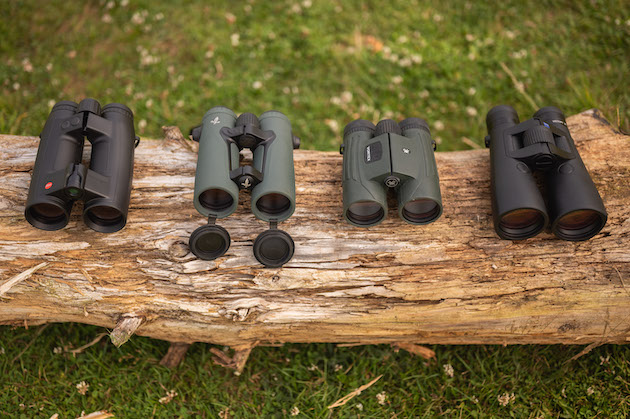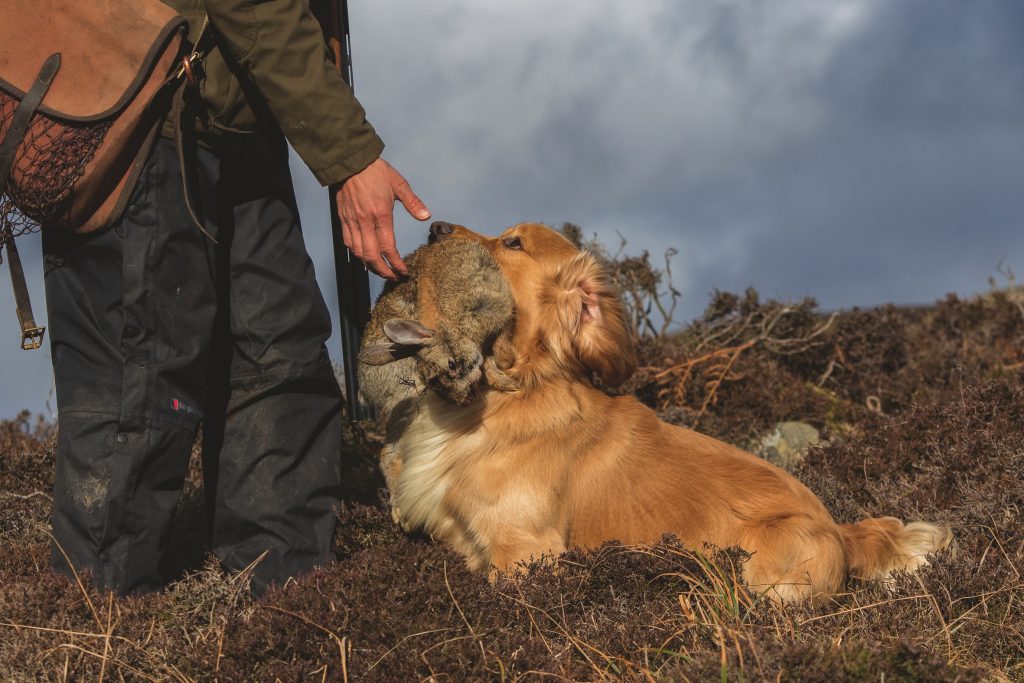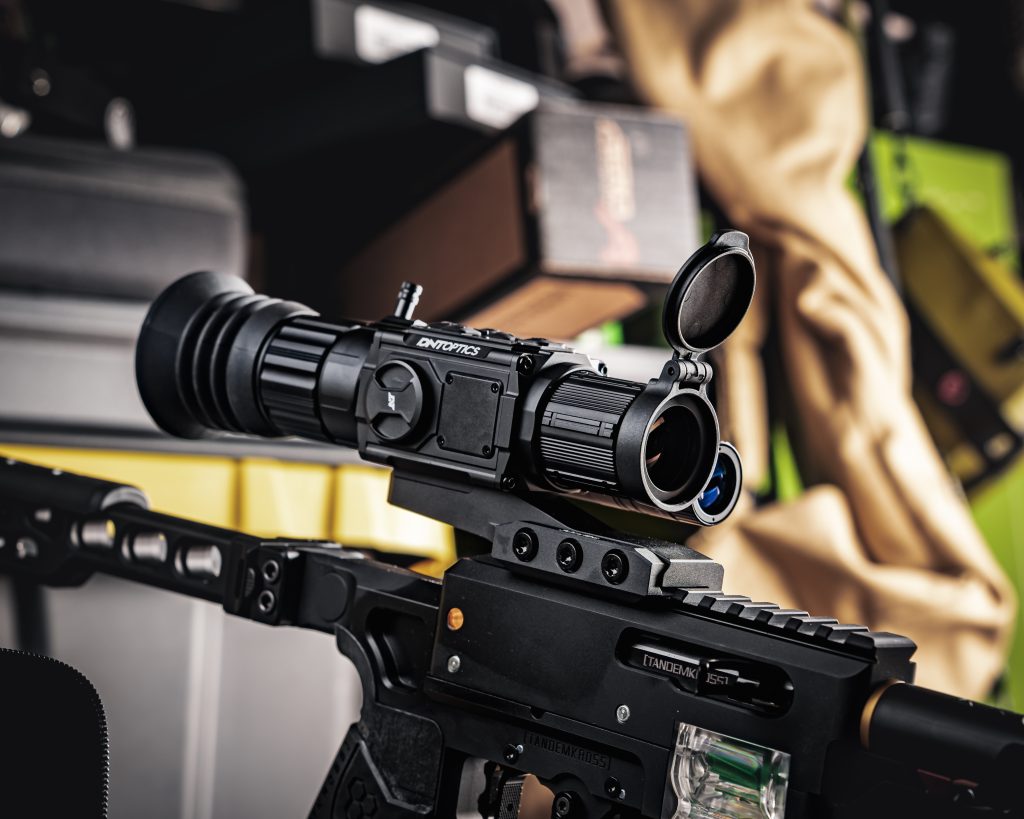Win CENS ProFlex DX5 earplugs worth £1,149 – enter here
The best rangefinding binoculars put through their paces
 Binoculars on test - Left to Right: Leica Geovid 3200.COM 10x42; Swarovski Optik EL Range 10x42; Vortex Fury HD 5000 10x42; Zeiss Victory RF 10x54
Binoculars on test - Left to Right: Leica Geovid 3200.COM 10x42; Swarovski Optik EL Range 10x42; Vortex Fury HD 5000 10x42; Zeiss Victory RF 10x54
Rangefinding binoculars are becoming increasingly popular in the UK, which is likely a direct result of their widespread use in the US. Across the pond, where big men drive big trucks, rangefinding optics have long been established as an essential item. The landscapes people hunt in, over there, are vast and Americans are also more willing to take ‘long shots’, requiring ballistic adjustment, which would likely be considered unethical or inappropriate by most UK deerstalkers.
However, it would be wrong to say that rangefinding optics are of no value to the UK deerstalker. In fact, it would be perfectly reasonable to suggest that carrying a rangefinder actually improves the the ethics of deerstalking because their use excludes the possibility of misjudging distance, leading to a poorly executed shot.
The benefits of rangefinding binoculars
Rangefinding binoculars provide an excellent option for those wishing to carry a rangefinder without needing another item of equipment. I would also suggest that those who shoot shotguns might find them useful. It is almost certainly the case that lots of us are not quite as good at judging range as we might think. In the past few years some truly amazing options have come to market.
The largest of the units tested, the Victory RF binos still felt comfortable in the hand
1. Zeiss Victory RF 10×54 RRP £2,899
The Victory RF binocular range from Zeiss is available in both x8 and x10 magnification with either 42mm or 54mm objective lenses. The 10×54 test model is perfect for deerstalking at twilight, with the larger objective lenses, combined with Zeiss’s T* coating, guaranteeing high-contrast imagery even in the worst light conditions. This unit outperformed all other test kits when fox shooting at dusk, delivering excellent visibility after the sun had dropped, allowing vital pest control to be carried out to help protect local breeding waders.
The Victory RF is the largest of all four binoculars tested, primarily due to the increased size of the objective lens. This was also noticeable in the weight of the unit, though the traditional design still felt comfortable in the hand.
The laser rangefinder is listed as being capable of precise measurements up to 2,300m. In field testing, this was reduced slightly to around 2,000m on large reflective targets and 900m on live quarry, which was more than ample when stalking roebuck in the weeks running up to the rut. The acquisition of distances was very fast; however, the display reading was noticeably quick to disappear. The rangefinder also has a useful scan function, for taking multiple ranges quickly on moving targets.
Zeiss knows that hunting optics need to be used in all weather conditions, and the Victory RF’s optics performed well in heavy rain.
The most expensive of all products tested, the Victory RF would be a significant financial investment for any casual deerstalker.
Summary: If you are wanting a lightweight pair of rangefinding binoculars, the Zeiss Victory RF in 10×54 are probably not for you; however, they are excellent in low light conditions and would be brilliant companions when stalking shaded woodland areas or carrying out fox control at dusk. 8.5/10
These impressive binos come with a comfortable and practical harness
2. Vortex Fury HD 5000 10×42 RRP £1,289
US-based company Vortex has created a product that truly reflects the landscapes and scenarios experienced by American hunters. The Fury HD 5000 binoculars have the most powerful rangefinder of all the test units, measuring distances on reflective targets up to a maximum range of 5,000 yards (4,572m). On non-reflective targets, such as deer, expect accurate measurements between 5m and 1,460m.
A two-button control panel makes using the rangefinder simple. Single readings can be achieved by pressing and releasing the ‘measure’ button, while holding down the same button puts the rangefinder into scan mode; this feature continuously relays ranges and is very useful on moving targets.
The Fury HD 5000s have a compact design but are slightly bulkier than the other test units and, despite being shorter in length, they still feel comfortable when held. The single-handed operation combined with sensitive controls helps to keep the optic steady when in use.
The glass quality in the Fury HD 5000s is very good, though you will have to work a little harder in poor light to identify targets in comparison with the other brands on test. This is a well-designed, armoured and durable piece of equipment, which is intended for regular use while returning accurate results.
This range is supplied with a Glasspak binocular harness as standard, which I find more comfortable and practical compared with the more traditional neck strap. This was particularly useful when crawling into a shooting position on the open hill or in clear-felled forestry, keeping the binoculars from becoming snagged and tangled.
As with all Vortex products, the Fury HD 5000s are covered by the Vortex VIP Warranty.
Summary: Don’t discount these binos because of their lower price. Superb build quality, excellent glass and a powerful rangefinder, combined with a lifetime guarantee, make this an impressive product that’s hard to overlook. 9/10
A single button activates the rangefinder
3. Swarovski Otik EL Range 10×42 RRP £2,890
Rangefinding binoculars often look cumbersome and oversized due to the inclusion of the internal rangefinder, but this is not the case for the Swarovski Optik EL Range. On first inspection, it is hard to distinguish the EL Range from its non-rangefinding counterpart, the EL binocular.
Because of the traditional design and equal distribution of weight on the underside of the unit, these binoculars feel extremely comfortable in the hand, and the lightweight design makes them suitable for carrying over long distances.
The rangefinder is simple to use: a small, discreet button to the side of the central focus is pressed to provide quick accurate ranges between 10m and 1,375m. There is also an easy-to-use scan function — simply hold the measurement button and the EL Range automatically starts giving continuous readings. The scan function is slightly slower on the Swarovskis when compared to that of the Vortex Fury HD 5000, which could be an issue if measuring a distance on a spooked target.
As expected from Swarovski, the glass in the EL Range is excellent and the picture is bright, clear and of high resolution. This was most beneficial when selecting suitable cull animals in poor light.
A desirable quality is the integrated Tracking Assist function. Using Bluetooth, the binoculars will link to your phone, allowing you to track any of the last three measured points, which are mapped as waypoints on a satellite image.
This useful piece of software can be used in situations where you are unsure of a positive strike or need to find a blood trail to locate a carcass or, in a worst-case scenario, a wounded animal.
Summary: As a hunting binocular, the Swarovski EL Range with Tracking Assist is revolutionary and will certainly improve the efficiency of locating blood trails and carcasses. Quality optics and an accurate rangefinder, all encased in a lightweight traditional body with state-of-the-art tracking software, make this an excellent piece of deerstalking kit. 9.5/10
The curved prism structure provides an ergonomic grip
4. Leica Geovid 32000.CO<10×42 RRP £2,750
On first impressions, the Leica Geovid 32000.COM appears to be a relatively large rangefinding binocular, yet its curved prism structure provides an ergonomic grip that comfortably fits even the largest hands. The evenly distributed weight makes for a well-balanced rangefinding binocular.
The glass quality is exceptional and the binoculars worked well in low light conditions, with even small targets such as rabbits being easy to locate at long distances in fading light. The rangefinder is capable of measuring targets between 10m and 2,950m. Like all the other test units, the Geovids contain a scan function that can be accessed by holding down the main button. Measurements are updated every half second as the binocular follows its target.
The Geovids can provide readings on temperature, shot angle and ballistic trajectory and are compatible with a Kestrel ballistics meter. These functions work well but could be confusing to the casual user.
Summary: A well-designed medium-weight unit that feels ergonomic and comfortable in the hand. The excellent internal rangefinder provides accurate readings quickly. This is a serious piece of scientific equipment but, in my opinion, it may be better suited to long-range target shooting rather than deerstalking. 8/10
Conclusion
All the rangefinding binoculars tested are an impressive combination of optical and rangefinding technology, with each having many things to offer. I have been impressed with them all individually; however, from a practical deerstalking perspective there are two units that stand out.
The Swarovski EL Range’s traditional lightweight design, good-quality glass and accurate rangefinder make this an exceptional product. With the addition of the Tracking Assist function, these binoculars become a revolutionary item that could improve the ethics of deerstalking. If budget was not a factor, these would be my pick of the rangefinding binoculars listed.
However, Vortex’s Fury HD 5000 is an impressive and accurate rangefinding optic. Giving consideration to the average UK deerstalker’s needs, the Fury HD 5000 meets all the requirements of a deerstalking rangefinding binocular at a price point and lifetime warranty that is unmatched by any other manufacturers. As such, the Vortex Fury HD 5000s would be my top choice.
Related Articles
Get the latest news delivered direct to your door
Subscribe to Shooting Times & Country
Discover the ultimate companion for field sports enthusiasts with Shooting Times & Country Magazine, the UK’s leading weekly publication that has been at the forefront of shooting culture since 1882. Subscribers gain access to expert tips, comprehensive gear reviews, seasonal advice and a vibrant community of like-minded shooters.
Save on shop price when you subscribe with weekly issues featuring in-depth articles on gundog training, exclusive member offers and access to the digital back issue library. A Shooting Times & Country subscription is more than a magazine, don’t just read about the countryside; immerse yourself in its most authoritative and engaging publication.







